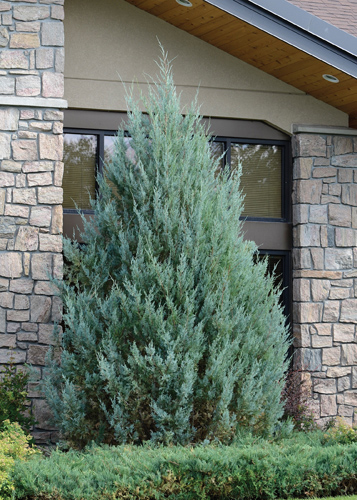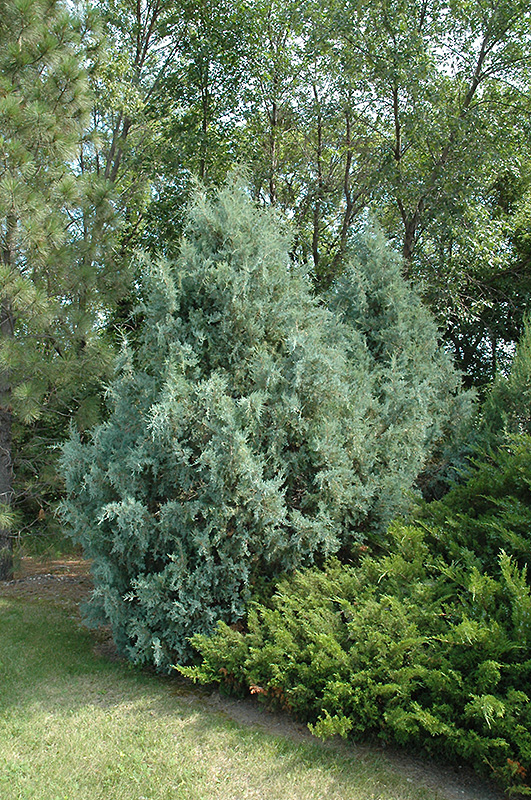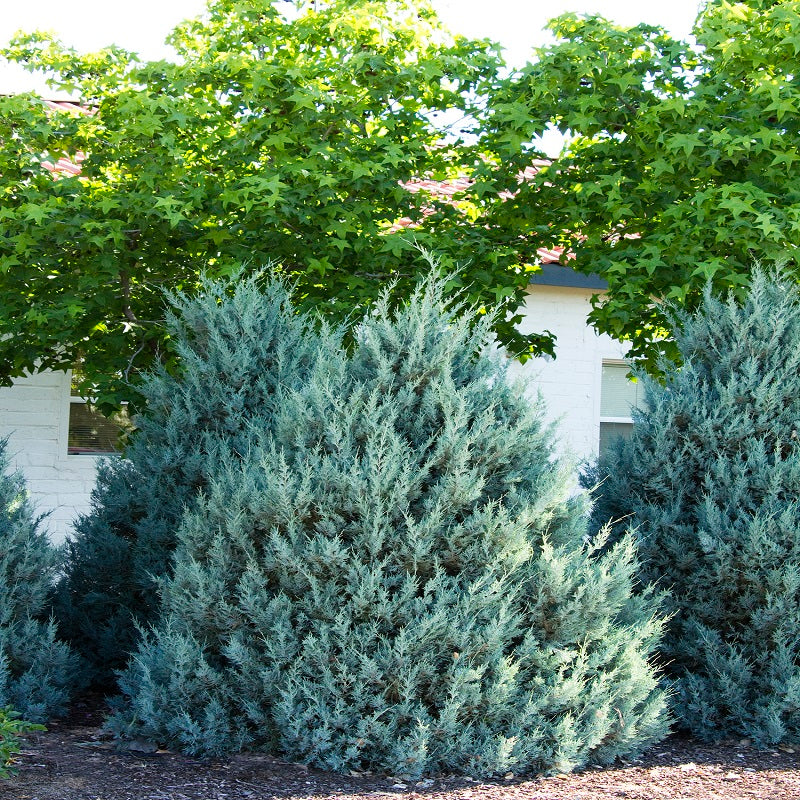One of the lovely hedge plants that we often see in school and college landscaping is the Wichita Blue Juniper. Hedge plants are characterized by their shrub-like appearance, closely spaced branches, and pyramidal form. According to the shape that would look best next to a college building or a school garden, these plants are clipped.
When you first see this hedge plant, you may not be able to determine its exact color because it is silver blue instead of dark green, and it shines all year long. It is typically employed as a two-sided border plant. As they tilt their heads in your direction or stand upright, they are pretty plants. In the face of severe winds, even these plants are more resilient than many others.
Foreground details:
According to Oregon State University, Wichita Blue Juniper are densely bushy shrub plants (trees) that develop at a height of about 18 feet (5.5 meters) with a spread of about 8 feet (2.5 meters). The scientific name for this shrub, which belongs to the Cupressaceae family, is Juniperus scopulorum “Wichita Blue.”
Rocky Mountain Juniper is one of the many names for this plant, which flourishes in USDA hardiness zone 3. The beauty of this plant is that you may shape it as you like by trimming its silver blue leaves, which develop in a pyramidal pattern. Juniperus scopulorum is hard to find and frequently sold out before anyone wants to purchase it.
Specification:
| Family | Cupressaceae |
| Scientfic Name | Juniperus scopulorum |
| USDA Hardiness Zone | 3-7 |
| Width | 5-8 feet |
| Height | 15-25 feet |
| Light | Full Direct Sunlight |
| Soil | fertile and well drained |
| Watering | Occasionally once Roots Established |
| Fertilizer | Liquid based |
| Uses | Screen cover , Window Hide, Windbreak |
Here are few links where you may get Wichita blue juniper:
Juniper Blue Arrow
PURCHASE CHECK IN AMAZON
Juniper Rug in Blue
ETSY PRICE CHECK (recommended)
Juniper Trees at Blue Point
ETSY PRICE CHECK (recommended)
Table of Contents
How to Grow Wichita Blue Juniper
You must first be aware of the USDA hardiness zones, which range from 3 to 7, in order to grow these shrub plants. These bushes enjoy receiving direct sunlight, which has no negative effects on their foliage (leaves). They need at least 5 to 6 hours of direct sunlight per day to grow their strength.
Grow Wichita Blue Juniper: Their roots are quickly adaptable to well-drained soil, and they really despise being wet in the soil. Sandier soil can be used for it to require the least amount of maintenance; they will still thrive there. You must consistently water these bushes when they are young since they need it at that time. Here are some pointers for growing juniper successfully:
Light
They enjoy being in the sun for 5 to 6 hours each day. Don’t worry, these plants won’t be harmed by the sunlight; they can survive droughts and hotter days.
Soil
Use any well-drained soil you like. Sand can be used with peat moss or compost in well-drained soil.
Pruning
Although you can prune Wichita Blue Juniper at any time of the year, experts advise doing it in the first few weeks of autumn. You can give it any shape you like, whether it’s circular, square, circle, polygonal, or any other shape you prefer. Pruning it once a year won’t hurt it; it will only accelerate its growth.
Don’t cut the entire branch off if it doesn’t have any foliage since if you do, it might not grow back. Because this tree has a pyramidal structure, it is important to maintain the top portion narrower than the bottom. Give it a good shape by trimming it.
Hedge or Screen
I used the terms “screen” or “hedge” to describe how this plant will act as a screen to block a view; it is ideal for people who have neighbors who look into other people’s homes.Many little plants that can only grow in shade are also shaded by it.
Fertilizer
Compost made organically is the greatest fertilizer for Wichita. Blue Juniper is a general-purpose fertilizer that benefits Juniperus scopulorum plants extremely well, but it ensures that there is no endless feed of fertilizer.
The ideal fertilizer for blue juniper is listed below.
Fertilizer
PURCHASE CHECK IN AMAZON
Watering
Smaller plants need consistent watering when they are young; after that, they can handle heat or drought very well. Avoid flooding the water since this could damage the plant’s root system. When the soil appears to be dry, water it.
Wichita Blue Juniper Care
Wichita Blue Juniper requires care, Watering needs to be consistent, but not excessive. This plant’s lack of seed drop means you don’t need to clean anything, which is a plus.
Because they are male shrubs and do not flower or produce berries that release seeds, they do not drop seeds. This makes them fewer care and maintenance plants, but they nevertheless have a very pleasing appearance. These bushes are ideal for creating excellent border lines in large gardens, and they are also perfect for creating stunning landscapes. These can be grown even in small gardens because they require very little maintenance.
Wichita Blue Juniper Propagation
The steps for growing Wichita Blue Juniper are as follows:
1. A healthy stem between 7 and 11 inches long must be trimmed.
and take out the bottom 3 inches’ worth of leaves.
2. Prepare a soil that drains effectively.
Using perlite and peat moss, moisten the soil by misting it with water until it drips out of the container.
3. Check that the pot has one or two holes in it.
then give the soil 25 minutes to set.
4. Use hormone for rooting.
which is available in both the online and offline markets, If it is a liquid, mix some water with it and submerge the cutting for one to two minutes. If it is a powder, dip the bottom of the stem in the powder.
Put this cutting in 5.
then completely water it in the container of prepared potting soil.
if you have two or three cuttings.
You can put several of this plant in the same pot, but make sure there is a 2 inch distance between each one.
Wichita Blue Juniper Pruning
Following are the steps for pruning Wichita Blue Juniper:
1. A sterilized cutting tool is required.
Do cut them to your desired length. Aim to avoid cutting the parent stem where the branches converge.
2. Look for dead branches and leaves.
By observing any dead branches or leaves, you may determine what needs to be removed. If you come across any sick leaves, remove them as well.
3. Avoid excessive cutting.
since they require some green leaves to stay on them to keep the plant’s core steady.
The dormant stem, number four.
It should be cut down because it won’t grow new branches or foliage.
5. Keeping Form in Mind.
You may easily prune it, removing any bulky branches you see but yet leaving some of the greener ones.
6. Only remove the withered leaves.
and discard the more robust ones. Don’t worry too much; even if you trim these bushes (Juniperus scopulorum ‘Wichita Blue’) incorrectly, they will undoubtedly grow back.
7. Shape it nicely, then leave it.
Its excessive growth can be controlled and new growth can be stimulated by trimming.
Here are few links where you may get Wichita blue juniper:
Juniper Blue Arrow
PURCHASE CHECK IN AMAZON
Juniper Rug in Blue
ETSY PRICE CHECK
Juniper Trees at Blue Point
ETSY PRICE CHECK
Wichita Blue Juniper Benefits
There are numerous advantages (uses) that you may be aware of and that you may not. I’ll discuss all of the applications for this shrub plant. These can be cut into any shape to suit the needs of their master. Here are some advantages of Wichita blue juniper:
Most Search Questions
Wichita blue juniper problems
Tip Blight for Phomopsis:
A fungus called Phomopsis juniperovora can cause Phomopsis Tip Blight in trees (Juniperus scopulorum ‘Wichita Blue’), which can make the tips of the leaves turn pale first, then change to reddish brown color, and then die. This condition is also known as dieback, which means infection starts from the tip of the leaves and it is the beginning slowly of your shrub dying with the disease.
Additionally, its stem develops cankers as well. Keep an eye on your plants because this all occurs due of the warm and humid circumstances in the summer and spring.
The Cercospora Twig Blight
Describes the Cercospora Twig Blight The lower branches of this shrub and the old stems may become infected by another fungus called Cercospora sequoiae var. juniperi. Over time, the lower branches begin to become brown, and eventually the entire plant dies.
Prevention & Approach:
You can use commercially available fungicides, but you should use them before the plants (Juniperus scopulorum ‘Wichita Blue’) become infected with these fungi.
You may have overwatered the plant, which can lead to root rot, or the plant may have experienced drought conditions.
If your shrub contracts these diseases, kindly use fungicides right away to prevent additional damage to the plants.
Another method is to remove the sick portion by pruning the dead branches and leaves.
Blue point juniper
Blue point juniper is a type of juniper with upright growth and a pyramidal shape, similar to wichita blue juniper. Additionally, they can endure heat and drought by standing still for extended periods of time. Additionally, this type naturally forms a pyramid, so trimming is not necessary to achieve this shape. This simply implies that upkeep for this shrub plant is not a major concern.
Dwarf wichita blue juniper
Both the Daniel’s Dwarf Juniper and the Dwarf Japanese Garden Juniper are dwarf cultivars of the wichita blue juniper, both of which are members of the Cupressaceae family. They are evergreen shrubs that do well in USDA zone 3, grow up to 18 feet high and 8 feet wide, are barren, and have gorgeous silver blue foliage.
Wichita blue juniper home depot , Sale , sale Near me
People are so interested in this tree that they are saturating search engines looking for sales and locations where they can buy it, including Home Depot. Customers in my area who want to purchase this magnificent shrub can visit an internet retailer. It can be delivered to your house safely and without any contact. Here is the purchase link.
FAQ’s
How do you plant a Wichita blue juniper?
To plant a Wichita blue juniper, you first need a good position where it receives adequate direct sunshine since these trees need at least 5-7 hours of sunlight each day to develop robust. Grow them on sandy soil if you want them to grow nicely; otherwise, you don’t need to give them any attention. This needs to have good drainage because if you flood them with water, the roots may rot and the plants may eventually die.
How big does a blue point juniper get?
How do you prune a Wichita blue juniper?
Wichita blue juniper pruning is simple and can be completed before spring as spring is when new growth begins. First, decide on the shape you want it to take before cutting it. Don’t forget to leave the main stem and the healthy stem alone, however you can trim them if you don’t go overboard. Pruning is a technique that can be used to get rid of infected brachens, inspect for faded leaves, and cut the ones that are impacted. I have detailed this article’s entire process above. To learn everything there is to know about Juniperus scopulorum prunes, please read that.
How do you keep junipers small?
The correct technique to maintain junipers tiny is to prune them periodically. Make sure not to overcut them and give them a good form. Don’t worry about cutting many branches; that is the way to rejuvenate their fresh development and make them disease-free.
How far apart should I plant blue point junipers?
Ordinary junipers trees can spread out to a width of up to 4-6 feet, so they should be placed 6 to 8 feet apart from one another. Additionally, if you are planting numerous blue point junipers, be sure to provide a distance of 11 to 12 feet between each tree so that no trees will be disturbed as they mature.
Is Wichita blue juniper deer resistant?
According to The State University of New Jersey, among the many varieties of junipers are Wichita blue juniper, Moonglow juniper, Prince of Wales juniper, Armstrong juniper, Blue Star juniper, Chinese juniper, Creeping juniper, Japanese Garden juniper, and Mountain juniper. Of these, only Shore Juniper is known to be resistant to deer.
Are junipers poisonous to dogs?
Yes, according to Davis List of Junipers (from University of California), these shrubs or trees are toxic or poisonous to children, dogs, and cats. However, the toxicity is minor, meaning it can cause indigestion that can result in vomiting or diarrhea. If you experience any other problems, please contact your local poison control center for assistance.
How fast do blue junipers grow?
The Blue Juniper is known to grow between 7 and 12 inches annually, reaching a height of 12 feet in 10 to 11 years. This tree sparkles all year long with its silver blue foliage and can even withstand full light. Although we can’t state that these shrub plants grow quickly because of the way they are grown, they do grow normally.
Conclusion
SEE ALSO:
Full Guide on Growing and Caring for the Jacob’s ladder Plant (Polemonium caeruleum)
How to Grow & Take Care of Japanese Blood Grass (Imperata Cylindrica) – A Guide
How to Grow, Prune, and Take Care of a Gold Mop Cypress [Step By Step]
Care, Pruning, and Propagation of Orange Star Plants [Detailed Guide]



